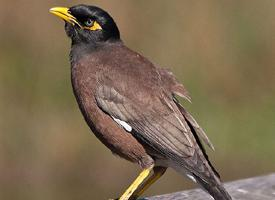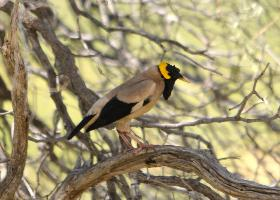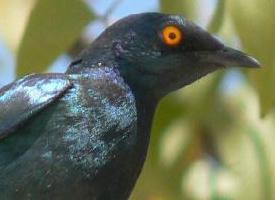
Poids et mesures
| Longueur | de 27 à 30 cm |
|---|
Statut de conservation
| Menacé |
Description de l'animal
The Common Hill Myna (Gracula religiosa), often simply referred to as the Hill Myna, is a captivating bird species renowned for its striking appearance and unparalleled vocal abilities. Native to the hill regions of South Asia and Southeast Asia, these birds have adapted to a variety of habitats, ranging from dense tropical forests to light woodlands and even human-inhabited areas, as long as there are trees suitable for nesting.Physically, the Common Hill Myna is a medium-sized bird, typically measuring between 23 to 26 cm in length. It possesses a predominantly glossy black plumage, which exhibits an iridescent sheen, reflecting shades of green, purple, and blue under sunlight. One of the most distinctive features of the Hill Myna is its bright orange-yellow patches of skin and wattles on the head, which contrast vividly against its dark feathers. Adding to its striking appearance are its strong, bright yellow legs and a robust, curved beak, which is also yellow, making it a truly eye-catching species.
The wings of the Common Hill Myna are large and rounded, enabling proficient flight, although they spend a considerable amount of time hopping from branch to branch or foraging on the ground. The tail is short and square, contributing to its balanced and robust physique.
However, it is the vocal prowess of the Hill Myna that truly sets it apart. Known as one of the best mimics among birds, it can replicate a wide range of sounds, including human speech, with astonishing clarity and emotion. In their natural habitat, these birds use a variety of calls, whistles, and other complex vocalizations to communicate with one another. When kept in captivity, they can learn to imitate human words, tunes, and even entire sentences, making them highly sought after as pets.
Their diet is omnivorous, consisting primarily of fruits, nectar, and insects. They have a particular fondness for figs, which constitute a significant portion of their diet in the wild. This varied diet helps them to thrive in a wide range of environments.
Breeding season for the Common Hill Myna usually occurs during the spring and early summer. They are cavity nesters, often choosing holes in trees to lay their eggs. The female typically lays two to three eggs, which both parents then incubate and care for. The strong pair bond and cooperative parenting are notable aspects of their breeding behavior.
Despite their popularity and adaptability, Hill Mynas face threats from habitat destruction and the pet trade. Their captivating vocal abilities have made them one of the most popular cage birds, leading to overexploitation in some areas. Conservation efforts are crucial to ensure that these unique birds can continue to thrive in their natural habitats.
In summary, the Common Hill Myna is a remarkable bird, not only for its stunning appearance and impressive mimicry skills but also for its adaptability and the role it plays in the ecosystem. Its presence enhances the biodiversity of its habitat, making it a species of significant ecological and cultural value.
Animaux similaires
Nouvelles photos d'animaux
Top 10 des animaux
- Dolphin gull (Leucophaeus scoresbii)
- Diana monkey (Cercopithecus diana)
- Moustached guenon (Cercopithecus cephus)
- Galápagos tortoise (Geochelone nigra complex)
- Japanese macaque (Macaca fuscata)
- Stone loach (Barbatula barbatula)
- Russian tortoise (Testudo horsfieldii)
- Greek tortoise (Testudo graeca)
- Common flying dragon (Draco volans)
- Vendace (Coregonus albula)


